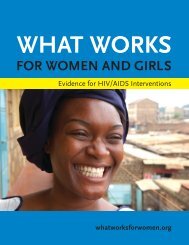Global Tuberculosis Report -- 2012.pdf
Global Tuberculosis Report -- 2012.pdf
Global Tuberculosis Report -- 2012.pdf
You also want an ePaper? Increase the reach of your titles
YUMPU automatically turns print PDFs into web optimized ePapers that Google loves.
BOX 5.2Technical assistance for TB care and controlThe <strong>Global</strong> Plan to Stop TB 2011–2015 highlights the important role of technical assistance to NTPs. The funding required over five years wasestimated at US$ 2.1 billion, or approximately US$ 400 million per year.The TB Technical Assistance Mechanism (TB-TEAM) of the Stop TB Partnership was established in 2007 to monitor and coordinate the provisionof technical assistance to NTPs. The secretariat function is carried out by WHO’s Stop TB Department. Requests from countries for technicalassistance are matched to appropriate technical partners via the TB-TEAM web site. Technical partners are expected to provide informationabout the purpose of the mission, the dates of travel, funding sources and a mission report via the website. All technical partners are invited toreview and comment on quarterly and annual analyses of data.TABLE B5.2.1Number of missions conducted by technical partners andreported to TB-TEAM, 2011PROVIDER OF TECHNICAL ASSISTANCENUMBER OFMISSIONS IN2011% OFTOTALWHO regional offi ces 126 20The Union 86 13KNCV <strong>Tuberculosis</strong> Foundation 67 10Centers for Disease Control and Prevention(CDC), USA60 9WHO headquarters 55 9<strong>Global</strong> Drug Facility 39 6WHO country offi ces 35 5Grant Management Solutions (GMS) project 33 5NTP/national TB-TEAM 25 4TB-REACH 19 3Other 100 16Total 645 100TABLE B5.2.2Number of missions by topic reported to TB-TEAM, 2009–2011TOPIC 2009 2010 2011In 2011, 645 missions were completed and reported to TB-TEAM(Table B5.2.1). About one third of recorded missions wereorganized by WHO, mainly by regional offi ces, and one third by theUnion, the KNCV <strong>Tuberculosis</strong> Foundation and the United StatesCenters for Disease Control and Prevention (CDC).In 2011, the main technical areas for which assistance was providedwere MDR-TB and XDR-TB; monitoring and evaluation linked toimpact measurement; the grant processes of the <strong>Global</strong> Fund;review missions; and laboratory strengthening (Table B5.2.2). Thedata also show that the number of missions fell between 2009 and2011. This downward trend occurred among most major technicalpartners, including WHO, the KNCV <strong>Tuberculosis</strong> Foundation andthe Union (data not shown), and was especially noticeable for threetopics: MDR and XDR-TB, management of drugs and commodities,and development of <strong>Global</strong> Fund proposals.Information on sources of funding is often not recorded; in the fi rsthalf of 2012, the source of funding was not recorded for 40% ofmissions. Of the 389 missions for which information on fundingwas provided, 78% was from agencies of the US government,notably the United States Agency for International Development(USAID) and OGAC (the Offi ce of the <strong>Global</strong> AIDS Coordinator). Theremaining 22% was from Eli Lilly and the Canadian InternationalDevelopment Agency (CIDA).% OFTOTAL IN2011MDR-TB and XDR-TB 120 129 91 14Monitoring and evaluation, supervision and impactmeasurement46 63 73 11<strong>Global</strong> Fund grant processes, bottlenecks 34 40 72 11TB programme planning and review; regional meetings 77 107 64 10Laboratory strengthening 54 79 57 9Drugs and commodities management 89 70 53 8Infection control 26 34 36 6Operational and basic science research 9 17 34 5TB/HIV 13 17 31 5Human resources development 27 39 23 4<strong>Global</strong> Fund proposal development 52 30 19 3Advocacy, communication and social mobilization 26 18 12 2Childhood TB 3 4 9 1Drug resistance surveillance 2 8 9 1Other 217 114 62 10Total 795 769 645 100The regional distribution of missions broadlycorrelates to TB burden (data not shown).An exception is the European Region, whichaccounts for 19% of missions but for 5% of TBcases reported globally. Most of the missions inthis region are related to MDR-TB and laboratorystrengthening. The South-East Asia Region has acomparatively low share of missions (12%) whilereporting almost 40% of TB cases globally. Oneexplanation may be that technical assistanceprovided from within-country sources in India isnot captured in the database.58 WHO REPORT 2012 GLOBAL TUBERCULOSIS CONTROL
















